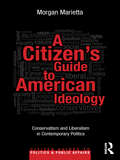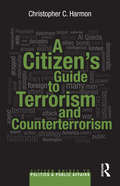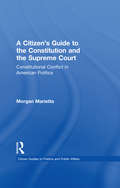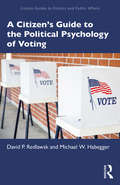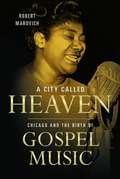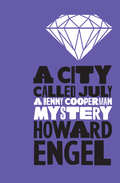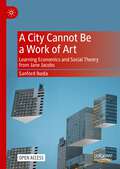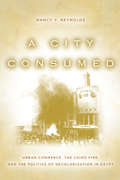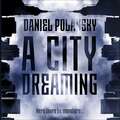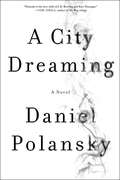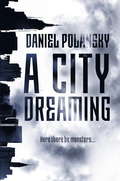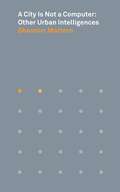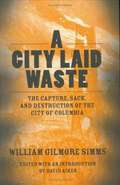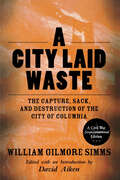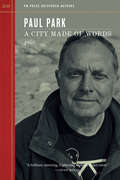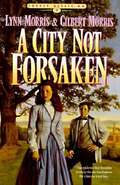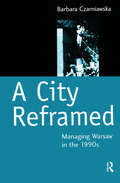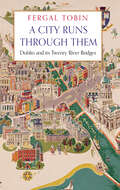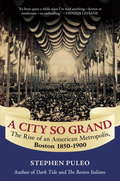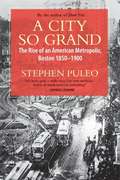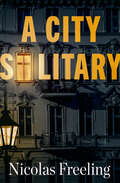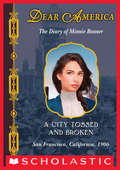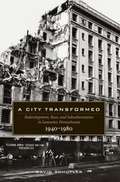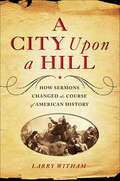- Table View
- List View
A Citizen’s Guide to American Ideology: Conservatism and Liberalism in Contemporary Politics
by Morgan MariettaConservatives and Liberals often resort to cartoon images of the opposing ideology, relying on broadly defined caricatures to illustrate their opposition.?To help us get past these stereotypes, this short, punchy book explains the two dominant political ideologies in America today, providing a thorough and fair analysis of each as well as insight into their respective branches. To help us understand the differences between the two contrasting ideologies, Morgan Marietta employs an innovative metaphor of a tree—growth from ideological roots to a core value, expanding into a problem that creates the competing branches of the ideology. This approach suggests a clear way to explain and compare the two ideologies in an effort to enhance democratic debate.? A Citizen’s Guide to American Political Ideologies is a brief, non-technical and conversational overview of one of the most important means of understanding political rhetoric and policy debates in America today.
A Citizen’s Guide to Terrorism and Counterterrorism
by Christopher C. HarmonThis Citizen’s Guide addresses the public policy issues of terrorism and counterterrorism in the United States after Bin Laden’s death. Written for the thinking citizen and student alike, this succinct and up-to-date book takes a "grand strategy" approach toward terrorism and uses examples and issues drawn from present-day perpetrators and actors. Christopher Harmon, a veteran academic of military theory who has also instructed U.S. and foreign military officers, organizes his book into four sections. He first introduces the problem of America’s continued vulnerability to terrorist attack by reviewing the long line of recent attacks and attempts against the U.S., focusing specifically on New York City. Part II examines the varied ways in which the U.S. is already fighting terrorism, highlighting the labors of diverse experts, government offices, intelligence and military personnel, and foreign allies. The book outlines the various aspects of the U.S. strategy, including intelligence, diplomacy, public diplomacy, economic counterterrorism, and law and law-making. Next, Harmon sketches the prospects for further action, steering clear of simple partisanship and instead listing recommendations with pros and cons and also including factual stories of how individual citizens have made a difference in the national effort against terrorism. This concise book will contribute to our understanding of the problems surrounding terrorism and counterterrorism—and the approaches the United States may take to meet them—in the early 21st century
A Citizen’s Guide to the Constitution and the Supreme Court: Constitutional Conflict in American Politics (Citizen Guides to Politics and Public Affairs)
by Morgan MariettaThe U.S. Constitution is a blueprint for a free society as well as a source of enduring conflict over how that society must be governed. The competing ways of reading our founding document shape the decisions of the Supreme Court, which acts as the final voice on constitutional questions. This breezy, concise guide explains the central conflicts that frame our constitutional controversies, written in clear non-academic language to serve as a resource for engaged citizens, both inside and outside of an academic setting. After covering the main points of conflict in constitutional law, Marietta gives readers an overview of the perspectives from the leading schools of constititional interpretation--textualism, common law constitutionalism, originalism, and living constitutionalism. He then walks through the points of conflict and competing schools of thought in the context of several landmark cases and ends with advice to readers on how to interpret constitutional issues ourselves.
A Citizen’s Guide to the Political Psychology of Voting (Citizen Guides to Politics and Public Affairs)
by David P. Redlawsk Michael W. HabeggerIn the run-up to a contentious 2020 presidential election, the much-maligned American voter may indeed be wondering, “How did we get here?” A Citizen’s Guide to the Political Psychology of Voting offers a way of thinking about how voters make decisions that provides both hope and concern. In many ways, voters may be able to effectively process vast amounts of information in order to decide which candidates to vote for in concert with their ideas, values, and priorities. But human limitations in information processing must give us pause. While we all might think we want to be rational information processors, political psychologists recognize that most of the time we do not have the time or the motivation to do so. The question is, can voters do a “good enough” job even if they fail to account for everything during the campaign? Evidence suggests that they can, but it isn’t easy. Here, Redlawsk and Habegger portray a wide variety of voter styles and approaches—from the most motivated and engaged to the farthest removed and disenchanted—in vignettes that connect the long tradition of voter survey research to real life voting challenges. They explore how voters search for political information and make use of it in evaluating candidates and their positions. Ultimately, they find that American voters are reasonably competent in making well-enough informed vote choices efficiently and responsibly. For citizen voters as well as students and scholars, these results should encourage regular turnout for elections now and in the future.
A City Called Heaven: Chicago and the Birth of Gospel Music
by Robert M. MarovichIn A City Called Heaven, gospel announcer and music historian Robert Marovich shines a light on the humble origins of a majestic genre and its indispensable bond to the city where it found its voice: Chicago. Marovich follows gospel music from early hymns and camp meetings through the Great Migration that brought it to Chicago. In time, the music grew into the sanctified soundtrack of the city's mainline black Protestant churches. In addition to drawing on print media and ephemera, Marovich mines hours of interviews with nearly fifty artists, ministers, and historians--as well as discussions with relatives and friends of past gospel pioneers--to recover many forgotten singers, musicians, songwriters, and industry leaders. He also examines how a lack of economic opportunity bred an entrepreneurial spirit that fueled gospel music's rise to popularity and opened a gate to social mobility for a number of its practitioners. As Marovich shows, gospel music expressed a yearning for freedom from earthly pains, racial prejudice, and life's hardships. In the end, it proved to be a sound too mighty and too joyous for even church walls to hold.
A City Called July (The Benny Cooperman Mysteries #5)
by Howard EngelWhen a trusted lawyer runs off with the savings of more than 50 clients, totaling around $2 million, Rabbi Meltzer and Saul Tepperman of the B'nai Shalom synagogue in Grantham, Ontario, know Benny Cooperman's just the man to track down the funds. Tepperman has known the detective since Cooperman's bar mitzvah, so the sleuth isn't in a position to turn down the request for help. This summer is bound to be a real scorcher, and the heat will be on Cooperman to solve the case. Cooperman's a detective with flair. Kinder and gentler than your average PI--and ironically squeamish about violence--he's the creation of author Howard Engel, a master of the crime genre whose enthusiastic fans have included Ruth Rendell, Donald E. Westlake, Julian Symons, and Tony Hillerman. Engel's readership spans 13 countries, including Japan, England, Germany, Italy, Spain, Denmark, the United States, and his native Canada.
A City Cannot Be a Work of Art: Learning Economics and Social Theory From Jane Jacobs
by Sanford IkedaThis open access book connects Jane Jacobs's celebrated urban analysis to her ideas on economics and social theory. While Jacobs is a legend in the field of urbanism and famous for challenging and profoundly influencing urban planning and design, her theoretical contributions – although central to her criticisms of and proposals for public policy – are frequently overlooked even by her most enthusiastic admirers. This book argues that Jacobs’s insight that “a city cannot be a work of art” underlies both her ideas on planning and her understanding of economic development and social cooperation. It shows how the theory of the market process and Jacobs’s theory of urban processes are useful complements – an example of what economists and urbanists can learn from each other. This Jacobs-cum-market-process perspective offers new theoretical, historical, and policy analyses of cities, more realistic and coherent than standard accounts by either economists or urbanists.
A City Consumed: Urban Commerce, the Cairo Fire, and the Politics of Decolonization in Egypt
by Nancy Y. ReynoldsThough now remembered as an act of anti-colonial protest leading to the Egyptian military coup of 1952, the Cairo Fire that burned through downtown stores and businesses appeared to many at the time as an act of urban self-destruction and national suicide. The logic behind this latter view has now been largely lost. Offering a revised history, Nancy Reynolds looks to the decades leading up to the fire to show that the lines between foreign and native in city space and commercial merchandise were never so starkly drawn. Consumer goods occupied an uneasy place on anti-colonial agendas for decades in Egypt before the great Cairo Fire. Nationalist leaders frequently railed against commerce as a form of colonial captivity, yet simultaneously expanded local production and consumption to anchor a newly independent economy. Close examination of struggles over dress and shopping reveals that nationhood coalesced informally from the conflicts and collaboration of consumers "from below" as well as more institutional and prescriptive mandates.
A City Dreaming
by Daniel PolanskyM is a drifter with a sharp tongue, few scruples, and limited magical ability, who would prefer drinking artisanal beer to involving himself in the politics of the city. Alas, in the infinite nexus of the universe which is New York, trouble is a hard thing to avoid, and now a rivalry between the city's two queens threatens to make the Big Apple go the way of Atlantis. To stop it, M will have to call in every favor, waste every charm, and blow every spell he's ever acquired - he might even have to get out of bed before noon.Enter a world of wall street wolves, slumming scenesters, desperate artists, drug-induced divinities, pocket steam-punk universes, and hipster zombies. Because the city never sleeps, but is always dreaming.(P) 2016 Hodder & Stoughton Limited
A City Dreaming: A Novel
by Daniel PolanskyA powerful magician returns to New York City and reluctantly finds himself in the middle of a war between the city's two most powerful witches."It would help if you did not think of it as magic. M certainly had long ceased to do so." M is an ageless drifter with a sharp tongue, few scruples, and the ability to bend reality to his will, ever so slightly. He's come back to New York City after a long absence, and though he'd much rather spend his days drinking artisanal beer in his favorite local bar, his old friends--and his enemies--have other plans for him. One night M might find himself squaring off against the pirates who cruise the Gowanus Canal; another night sees him at a fashionable uptown charity auction where the waitstaff are all zombies. A subway ride through the inner circles of hell? In M's world, that's practically a pleasant diversion. Before too long, M realizes he's landed in the middle of a power struggle between Celise, the elegant White Queen of Manhattan, and Abilene, Brooklyn's hip, free-spirited Red Queen, a rivalry that threatens to make New York go the way of Atlantis. To stop it, M will have to call in every favor, waste every charm, and blow every spell he's ever acquired--he might even have to get out of bed before noon. Enter a world of Wall Street wolves, slumming scenesters, desperate artists, drug-induced divinities, pocket steampunk universes, and demonic coffee shops. M's New York, the infinite nexus of the universe, really is a city that never sleeps--but is always dreaming.
A City Dreaming: A Novel
by Daniel PolanskyImagine a city within a city, where monsters walk the street and magic fills the night. This is New York, but not as you know it. This New York is a city of magic and monsters. Where ordinary people live alongside demons and nightmares, completely unaware of them. New York is home to M, a man with a past... and a secret. He knows more about the creatures who call his city home than anyone else in the world. He walks between the two worlds, at home in neither but more than comfortable in both. M is the man the monsters call when things get bad.And things are about to get really, really bad.
A City Is Not a Computer: Other Urban Intelligences (Places Books #2)
by Shannon MatternA bold reassessment of "smart cities" that reveals what is lost when we conceive of our urban spaces as computersComputational models of urbanism—smart cities that use data-driven planning and algorithmic administration—promise to deliver new urban efficiencies and conveniences. Yet these models limit our understanding of what we can know about a city. A City Is Not a Computer reveals how cities encompass myriad forms of local and indigenous intelligences and knowledge institutions, arguing that these resources are a vital supplement and corrective to increasingly prevalent algorithmic models.Shannon Mattern begins by examining the ethical and ontological implications of urban technologies and computational models, discussing how they shape and in many cases profoundly limit our engagement with cities. She looks at the methods and underlying assumptions of data-driven urbanism, and demonstrates how the "city-as-computer" metaphor, which undergirds much of today's urban policy and design, reduces place-based knowledge to information processing. Mattern then imagines how we might sustain institutions and infrastructures that constitute more diverse, open, inclusive urban forms. She shows how the public library functions as a steward of urban intelligence, and describes the scales of upkeep needed to sustain a city's many moving parts, from spinning hard drives to bridge repairs.Incorporating insights from urban studies, data science, and media and information studies, A City Is Not a Computer offers a visionary new approach to urban planning and design.
A City Laid Waste: The Capture, Sack, and Destruction of the City of Columbia
by William Gilmore SimmsA City Laid Waste captures in riveting detail the destruction of South Carolina's capital city, a native South Carolinian and one of the nation's foremost men of letters, was in Columbia and witnessed firsthand the city's capture by Union forces and its subsequent devastation by fire. Simms recorded the events in a series of eyewitness and accounts published in the first ten issues of the Columbia Phoenix.
A City Laid Waste: The Capture, Sack, and Destruction of the City of Columbia
by William Gilmore Simms“A graphic account of the horrors, the brutality and sometimes wanton destruction of warfare, particularly of civil war.” —Charleston (SC) Post and CourierIn the first reissue of these documents since 1865, A City Laid Waste captures in riveting detail the destruction of South Carolina’s capital city. William Gilmore Simms (1806-1870), a native South Carolinian and one of the nation’s foremost men of letters, was in Columbia and witnessed firsthand the city’s capture and destruction. A renowned novelist and poet, who was also an experienced journalist and historian, Simms deftly recorded the events of February 1865 in a series of eyewitness accounts published in the first ten issues of the Columbia Phoenix and reprinted here. His record of burned buildings constitutes the most authoritative information available on the extent of the damage. Simms historian David Aiken provides a historical and literary context for Simms’s reportage. In his introduction Aiken clarifies the significance of Simms’s articles and draws attention to factors most important for understanding the occupation’s impact on the city of Columbia.“A shrewd viewer of the war scene in Columbia, famed Southern writer William Gilmore Simms published stinging, courageous exposés of the doings of the Northern forces, even when threatened with arrest. The restoration of his candid firsthand accounts of the destruction wrought by Sherman’s forces against the South Carolina capitol and its inhabitants is a great service to all who study and appreciate Southern history and literature.” —James Everett Kibler, author of Our Fathers’ Fields
A City Made of Words: Outspoken Authors (Outspoken Authors)
by Paul ParkPaul Park is one of modern fiction's major innovators. With exotic settings and characters truly alien and disturbingly normal, his novels and stories explore the shifting interface between traditional narrative and luminous dream, all in the service of a deeper humanism. "Climate Change," original to this volume, is an intimate and erotic take on a global environmental crisis. "A Resistance to Theory" chronicles the passionate (and bloody) competition between the armed adherents of postmodern literary schools. "A Conversation with the Author" gives readers a harrowing look behind the curtains of an MFA program. In "A Brief History of SF" a fan encounters the ruined man who first glimpsed the ruined cities of Mars. "Creative Nonfiction" showcases a professor's eager collaboration with a student intent on wrecking his career. The only nonfiction piece, "A Homily for Good Friday," was delivered to a stunned congregation at a New England church. Plus: A bibliography, and our candid and colorful Outspoken Interview with one of today's most accomplished and least conventional authors, in which personal truth is evaded, engaged, and altered, all in one shot.
A City Not Forsaken (Cheney Duvall, M. D. #3)
by Gilbert Morris Lynn MorrisWill Cheney Be Content in the Glittering Lights of High Society? OR NOT Cheney Duvall's attempt to help the mountain folks in the primitive wilderness of the Ozark Mountains had proven to be an extremely difficult experience for both her and her nurse, Shiloh Iron. When they return to her home in New York; Cheney determines to go into a private practice with the handsome Devlin Buchanan, a highly successful physician who had previously asked her to marry him. His sponsorship offered her an excellent chance for success among the most wealthy and refined residents of New York. But dark rumors of plague had reached New York well in advance of the arrival of the ship that was bringing Devlin Buchanan back from London. A cholera outbreak in London had been reported in the early spring of 1866, and the deadly pestilence was now transported on the steamship Virginia. Despite holding the ship in quarantine, New Yorkers knew it was only a matter of time before the disease would spread. Polite Society with its elite circles, glittering stores, finest of clothing, elegant carriages, and lush carpet is a far different world than Cheney has known. And while it's gratifying to brush elbows with the Rockefellers and Vanderbilts, her past work has left its mark deep in her soul. Can Cheney be content in a world of high society and pomp, or will the call of the poor and the horrors of the epidemic draw her back?
A City Reframed: Managing Warsaw in the 1990's (Cities And Regions Ser. #Vol. 4)
by Barbara CzarniawskaManagement of big cities is a relatively unresearched area, as compared to city planning and city governance. A study of Warsaw city management reveals the transformation process typically found in European countries in political and economic transition. In A City Reframed, Czarniawska conceptualises city management as an "action-net" under transformation, where three types of action are in focus: "muddling through", or coping with daily problems; "reframing", or changing the frame of interpretation of the world in order to take successful action; and "anchoring", the testing of new ideas on potentially involved parties in order to secure cooperation or minimize resistance. "Muddling through" is central to management in Warsaw, as it no doubt has always been: it is this "muddling through" that makes cities function. The specificity of the Warsaw picture is its demand for "reframing" and numerous and varied attempts have been made to achieve a "change of frame". They were sometimes successful, sometimes not, the skill of anchoring only slowly emerging from the most recent past, with the sediments of the old regimes an obvious obstacle. The study pinpoints the phenomena central to the construction of the action-net of city management, and traces its further connections (or lack of such), both temporally and spatially.
A City Runs Through Them: Dublin and its Twenty River Bridges
by Fergal TobinAn original and fascinating history of Dublin that tells the story of the city through its bridges.Dublin's twenty bridges cross the tidal section of the River Liffey flowing through its centre; they were built over a span of a thousand years. Each has made a contribution to the city's development over time, so much so that it is possible to piece together its history by tracing their construction in chronological order.Starting with Church Street Bridge, Dublin's first, which dates back to the Vikings, and ending with the Rosie Hackett Bridge, erected in 2014, Fergal Tobin charts the rise of Ireland's capital city as never before and reveals how it has been truly made by its bridges.
A City So Grand
by Stephen PuleoOnce upon a time, "Boston Town" was an insulated New England township. But the community was destined for greatness. Between 1850 and 1900, Boston underwent a stunning metamorphosis to emerge as one of the world's great metropolises-one that achieved national and international prominence in politics, medicine, education, science, social activism, literature, commerce, and transportation. Long before the frustrations of our modern era, in which the notion of accomplishing great things often appears overwhelming or even impossible, Boston distinguished itself in the last half of the nineteenth century by proving it could tackle and overcome the most arduous of challenges and obstacles with repeated-and often resounding-success, becoming a city of vision and daring.In A City So Grand, Stephen Puleo chronicles this remarkable period in Boston's history, in his trademark page-turning style. Our journey begins with the ferocity of the abolitionist movement of the 1850s and ends with the glorious opening of America's first subway station, in 1897. In between we witness the thirty-five-year engineering and city-planning feat of the Back Bay project, Boston's explosion in size through immigration and annexation, the devastating Great Fire of 1872 and subsequent rebuilding of downtown, and Alexander Graham Bell's first telephone utterance in 1876 from his lab at Exeter Place.These lively stories and many more paint an extraordinary portrait of a half century of progress, leadership, and influence that turned a New England town into a world-class city, giving us the Boston we know today.From the Hardcover edition.
A City So Grand: The Rise of an American Metropolis, Boston 1850-1900
by Stephen PuleoBetween 1850 and 1900, Boston underwent a stunning metamorphosis from an insulated New England town into one of the world's great metropolises--one that achieved worldwide prominence in politics, medicine, education, science, social activism, literature, commerce, and transportation. In A City So Grand, Stephen Puleo chronicles this remarkable period in Boston's history. He takes readers through the ferocity of the abolitionist movement of the 1850s, the thirty-five-year engineering and city-planning feat of the Back Bay project, Boston's explosion in size through immigration and annexation, the devastating Great Fire of 1872, and the glorious opening of America's first subway station in 1897. This lively journey paints a portrait of a half century of progress, leadership, and influence.
A City Solitary
by Nicolas FreelingFrom an Edgar award–winning author, a psychological thriller about a crime victim who turns criminal when he goes on the run with his assailants. Middle-aged writer Walter Forestier’s ordinary existence takes a turn towards violence when he is viciously attacked at home, robbed, and left bound for his wife to find him. Of course, she wants to call the police, but Walter refuses. Even more mysterious, when the burglars strike again, Walter will not testify against them. Instead, he finds himself a party to the gang leader’s escape from jail, and once on the road through France with the band of thieves, Walter’s life will never be the same again.Praise for Nicolas Freeling:“In depth of characterization, command of language and breadth of thought, Mr. Freeling has few peers when it comes to the international policier.” —The New York Times“Nicolas Freeling . . . liberated the detective story from page-turning puzzler into a critique of society and an investigation of character.” —The Daily Telegraph“Freeling rewards with his oblique, subtly comic style.” —Publishers Weekly“Freeling writes like no one. . . . He is one of the most literate and idiosyncratic of crime writers.” —Los Angeles Times
A City Tossed and Broken: A City Tossed And Broken (Dear America)
by Judy BlundellFrom National Book Award-winning author Judy Blundell, a thrilling account of the San Francisco Earthquake of 1906.When Minnie Bonner's father disappears after losing the Bonners' Philadelphia tavern, the wealthy gentleman Edward Sump, led by his avaricious wife, offers Minnie a chance to work as a lady's maid to support her family. The Sumps have grand plans, grander than the city of Philadelphia can offer, however, and decide to move to San Francisco -- the greatest city in the west. But when a powerful earthquake strikes, Minnie finds herself the sole survivor among them. After the dust settles, Minnie discovers a bag belonging to the Sumps filled with cash and papers that could drastically change her fortune. With no one else to claim it, Minnie has turned into an heiress overnight. Wealth comes at a price, though, and she is soon wrapped up in a deception that leads her down a dangerous path. As the aftermath of the earthquake ravages the city, Minnie continues to maintain her new identity. That is, until a mysterious but familiar stranger appears.
A City Transformed: Redevelopment, Race, and Suburbanization in Lancaster, Pennsylvania, 1940-1980
by David SchuylerAs was true of many American cities, Lancaster, Pennsylvania, adopted urban renewal programs in the postwar years to revitalize a downtown that was experiencing economic decline. As the commercial and residential infrastructure of the city decayed, people and jobs migrated to the suburbs. Urban renewal was supposed to make the downtown viable again as a site for both businesses and residences. But as David Schuyler shows in A City Transformed, redevelopment in Lancaster resulted in more failures than successes. Beginning in the 1950s, the Lancaster Redevelopment Authority implemented a comprehensive revitalization program that changed the physical shape of the city. In attempting to solidify the retail functions of the traditional central business district, redevelopment dramatically altered key blocks of the downtown, replacing handsome turn-of-the-century Beaux Arts structures with modernist concrete boxes and a sterile public square. The strategy for eliminating density and blighted buildings resulted in the demolition of whole blocks of dwellings and, perhaps more importantly, destabilized Lancaster's African American community. A City Transformed is a compelling examination of a northern city struggling with its history and the legacy of segregation. But the redevelopment projects undertaken by the city, however ambitious, could not overcome the suburban growth that continues to sprawl over the countryside or the patterns of residential segregation that define city and suburb. When the Redevelopment Authority ceased operating in 1980, its legacy was a city with a declining economy, high levels of poverty and joblessness, and an increasing concentration of racial and ethnic minorities—a city very much at risk. In important ways what happened in Lancaster was the product of federal policies and national trends. As Schuyler observes, Lancaster's experience is the nation's drama played on a local stage.
A City Upon a Hill: How Sermons Changed the Course of American History
by Larry Witham“Witham’s highly readable history of the American sermon strongly bolsters the contention that words change minds and alter the course of events.” —BooklistPivotal moments in U.S. history are indelibly marked by the sermons of the nation’s greatest orators. From colonial times to the present, the sermon has motivated Americans to fight wars as well as fight for peace. Sermons have provoked the mob mentality of witch hunts and blacklists, but they have also stirred activists in the women’s and civil rights movements. A City Upon a Hill tells the story of these powerful words and how they shaped the destiny of a nation.A City Upon a Hill includes the story of Robert Hunt, the first preacher to brave the dangerous sea voyage to Jamestown; Jonathan Mayhew’s “most seditious sermon ever delivered,” which incited Boston’s Stamp Act riots in 1765; early calls for abolition and “Preacher-Captain” Nat Turner’s bloody slave revolt of 1831; Henry Ward Beecher’s sermon at Fort Sumter on the day of Lincoln’s assassination; tent revivalist/prohibitionist Billy Sunday’s “booze sermon”; the challenging words of Martin Luther King Jr., which inspired the civil rights movement; Billy Graham’s moving speeches as “America’s pastor” and spiritual advisor to multiple U.S. presidents; and Jerry Falwell’s legacy of changing the way America does politics.A City Upon a Hill provides a history of the United States as seen through the lens of the preached words—Protestant, Catholic, and Jewish—that inspired independence, constitutional amendments, and military victories, and also stirred our worst prejudices, selfish materialism, and stubborn divisiveness—all in the name of God.
